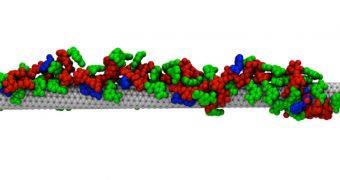A group of chemicals engineers at the Massachusetts Institute of Technology (MIT) announce the development of devices called synthetic antibodies. Their innovation relies on the use of nanoparticles for recognizing specific molecules in a mixture similar to the human blood stream.
The invention could be useful for a wide array of applications, ranging from chemical detection to durable high-tech sensors that could be used in security-related settings. Creating these synthetic antibodies was only made possible by the use of nanometer-thick carbon tubes (CNT).
One of the most intriguing properties of carbon nanotubes is that they become fluorescent when exposed to laser light. This trait has allowed researchers to use CNT for chemical recognition, by covering it up with antibodies that bind to certain molecules, and then analyzing how the fluorescence patterns change over time.
Any brightening or dimming trend in CNT fluorescence would indicate that the particles have attached themselves to whatever chemicals the antibodies on their surface were designed to bind to. The new study takes this technique one step further, says the senior author of the study, Michael Strano.
He holds an appointment as the Carbon P. Dubbs professor of chemical engineering at the Institute. Details of his team's work are published in the November 24 online issue of the top scientific journal Nature Nanotechnology.
“This new technique gives us an unprecedented ability to recognize any target molecule by screening nanotube-polymer complexes to create synthetic analogs to antibody function,” Strano explains.
Thus far, the research group has been able to develop CNT-based detectors for chemicals including estradiol, L-thyroxine and riboflavin, all of which play important roles in the human body. The team is now focused on creating detectors for other compounds as well, including proteins, neurotransmitters and carbohydrates, among others.
“This new concept, being based on the molecular recognition from the adsorbed phase itself, does not require the use of antibodies or equivalent molecules to achieve specific molecule recognitions and thus provides a promising alternative route for ‘on demand’ molecular sensing,” comments Laurent Cognet.
The expert, who was not involved with the research team, holds an appointment as a senior scientist with the Institute of Optics at the University of Bordeaux The new study was supported by funds from the US National Science Foundation (NSF) and the Army Research Office.

 14 DAY TRIAL //
14 DAY TRIAL //